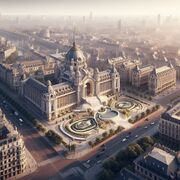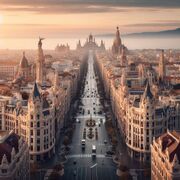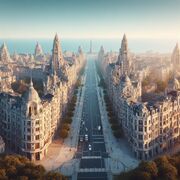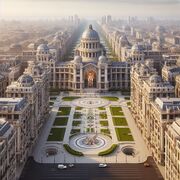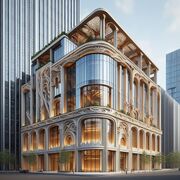Art Nouveau in Burgundie: Difference between revisions
Tag: 2017 source edit |
Tags: Mobile edit Mobile web edit Advanced mobile edit |
||
| Line 53: | Line 53: | ||
| alt5= | | alt5= | ||
}} | }} | ||
{{Gallery | |||
| title = Neo Art Nouveau Architecture in [[Burgundie]] | |||
| align =center | |||
| footer = | |||
| style = | |||
| state = | |||
| height = | |||
| width = | |||
| captionstyle = | |||
| File:GLW HQ.jpeg | |||
| HQ of [[Gerin-Lajoie Weaponeering]], completed in [[2025]], in [[Equatorial Ostiecia]]. | |||
| alt1= | |||
}} | |||
[[Category: Graphics Requested]] | [[Category: Graphics Requested]] | ||
[[Category:Problem Article]] | [[Category:Problem Article]] | ||
Revision as of 05:27, 25 October 2023
The Art Nouveau movement,(Burg:Ars Nouvo) peaked in Burgundie between 1893 and 1919, particularity leading up to the centennial of the country in 1912. Its revival movement was popular from 1993-2031 called Centennial Rival Style (Burg): Renaissance du Centenarie) or Bicentennial Style improved as building techniques allowed for grander scales in the revival.
History
Art Nouveau in Burgundie was largely influenced by Kantotism, or a fascination with eastern Alsharite culture. The swooping, floral, and natural repeating patterns in Kantotese art formed the backbone of the Burgundian Art Nouveau movement. Burgundian traders, art dealers, scholars, and upper middle class citizens imported large amounts of Kantotese goods and artisans. The fad became synonymous with wealth and social standing. Young Burgundian artisans and civil engineers looking to establish a grander, new style adapted the oriental concepts to fit more readily into the northern Levantine cultural environment. They established the Ars Nouvo Escole in 1892, and began to formalize the tenants of their movement.
They partnered with the growing field of public health to design new cities to deal with the cramped funtionalism of industrial Burgundie and to bring colonial Burgundie into the 20th century with Levantine Burgundie.
Ankivara Experiment
Main article: Legatation_of_Ankivara § City_redevelopment
One of the schools first endeavors was to redesign the city layout for the Legatation of Ankivara. The city was filthy, ancient and lacked basic amenities in the vast native quarters. It was planned that during the Burgundians next administrative]] cycle they wpuld level the city and rebuild it from the ground up as a gift to the Recepi residents.
Petit Casteth della Desir
The Petit Casteth della Desir is assumed to the be the headquarters of the Burgoignesc Defense Intelligence Agency. It is in the town of Mattiusvale on the Isle of Burgundie. It was built in 1897-1898 in preparation for the La Gran Sortide in neighboring Vilauristre, in the Art Nouveau style. At the time it was considered not only an Art Nouveau masterpiece but also a beautiful blending of contemporary Burgoignesc style and its Hištanšahri past. This has since been found to be anachronistic as the turret is designed in the style of a minaret and open-air Latinate Mashrabiyas are both from hundred of years after the Nestorians fled Audonia during the rise of the Oduniyyad Caliphate. It is still considered a beautiful building brimming with Art Nouveau detailing and the misattributions common of the Orientalism of the time.
The name Petit Casteth della Desir directly translates to "little castle of desire", but is more intentionally translated to little palace of yearning. It is a architectural interpretation of the Burgoignesc societal search for its mythical homeland, in the valleys the Hištanšahri Nestorians fled.
The building was originally used as a hotel for the duration of the La Gran Sortide and for a few decades after. In 1932, it was bought by the wealthy de Mamotlac family and converted into a residence. The de Mamotlacs made both cosmetic and structural changes to the interior of the building to accommodate running water, electricity, and gas heating. These improvements were in some case so invasive that portions of the house are unrecognizable as their Art Nouveau motifs have been damaged beyond repair or removed. In 1984, the Government bought the building promising that would be restored to its original splendor and converted into a museum. This never came to fruition and it has been assumed that the Defense Intelligence Agency took over the building in 1992 after extensive renovations.
